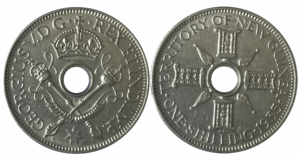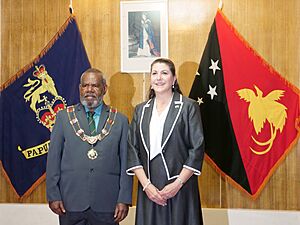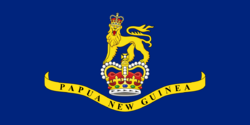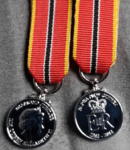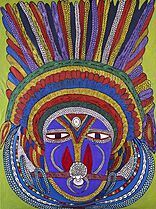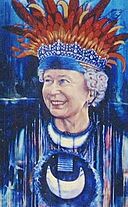Monarchy of Papua New Guinea facts for kids
Quick facts for kids King of Papua New Guinea |
|
|---|---|

Emblem of Papua New Guinea
|
|
| Incumbent | |
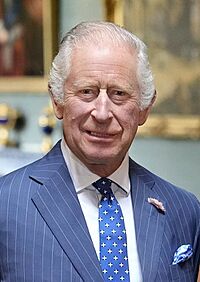 |
|
| Charles III since 8 September 2022 |
|
| Details | |
| Style | His Majesty |
| Heir apparent | William, Prince of Wales |
| First monarch | Elizabeth II |
| Formation | 16 September 1975 |
The monarchy of Papua New Guinea is a special way of governing where a monarch (a king or queen) is the head of state. This role is passed down through their family. Since September 8, 2022, King Charles III has been the King of Papua New Guinea. He represents the country's Crown.
Even though King Charles III is also the monarch for 14 other independent countries in the Commonwealth of Nations, each country's monarchy is separate. So, he is officially called the King of Papua New Guinea. He and other members of the royal family do public and private duties for Papua New Guinea. But only the King has a real role in the country's laws.
The King holds all the main government power. His approval is needed for certain official documents to become law. However, this power actually comes from the people of Papua New Guinea. The King's direct involvement in daily government is small. Most powers are used by elected members of parliament, government ministers, and judges. Some powers, like firing a prime minister, are very important but are only used in special situations to keep the government stable.
Today, the Crown helps make sure the government runs smoothly and fairly. It acts as a neutral protector against anyone trying to misuse power. While the King has some unique powers, most of his duties are carried out by his representative, the Governor-General of Papua New Guinea.
Contents
History of Papua New Guinea's Monarchy
The first Europeans to try to settle in the area were the British in 1793. But it was the Dutch who claimed the western part of the island in 1828. They didn't really control it until 1898.
In 1884, Germany took control of the northeast part of the island, calling it German New Guinea. In the same year, Britain claimed the southern coast, calling it British New Guinea. This area became part of Australia in 1902 and was renamed the Territory of Papua in 1906. During World War I, Australian forces took over German New Guinea. In 1921, Australia was given control of this area by the League of Nations.

In 1945, Australia combined its control of Papua and New Guinea into the Territory of Papua and New Guinea. This territory was managed by Australia from 1946 as a United Nations trust territory. Papua New Guinea held elections for a House of Assembly in 1964, 1968, and 1972. It gained self-government on December 1, 1973, and became fully independent from Australia on September 16, 1975.
Becoming an Independent Monarchy
In February 1974, Queen Elizabeth II of Australia visited Papua New Guinea. She said that independence was coming soon. She also promised Australia's continued friendship and help. Chief Minister Michael Somare said Papua New Guinea wanted to join the Commonwealth of Nations.
At first, it was decided that the head of state would be a citizen of Papua New Guinea. But on May 19, 1975, the government suddenly announced that they would ask the Queen to be the head of state. They felt that keeping ties with the Queen would give a "sense of security" during the early years of independence.
Some university students and opposition members protested this decision. But Michael Somare urged politicians not to argue about the Queen's role. He said her position would not take away from the country's independence. Many groups across the country supported Somare's choice.
On June 5, 1975, the Constituent Assembly voted against making Papua New Guinea a republic. On August 15, 1975, they officially adopted the Constitution. They invited the Queen to be their head of state and asked her to approve John Guise as the first governor-general of Papua New Guinea. Queen Elizabeth II was happy to accept. Papua New Guinea was the first Commonwealth country to specifically ask Queen Elizabeth II to be its monarch.
At the independence celebrations in 1975, the Queen's son, Charles, Prince of Wales (who is now King Charles III), represented her. On September 16, 1975, Papua New Guinea officially became independent. The Prince of Wales then opened the first parliament in Port Moresby.
Papua New Guinea's Crown and Its Role
Papua New Guinea is one of fifteen independent countries, called Commonwealth realms, that share the same monarch. The monarch's role in Papua New Guinea is completely separate from his role in any other country. Even though they share the same person as monarch, each Commonwealth realm is independent. The monarch is represented in Papua New Guinea by a viceroy, who is the governor-general.
Since Papua New Guinea's independence in 1975, the Crown has been both shared and unique. The monarch's role as King of Papua New Guinea is different from his role as monarch of the United Kingdom. This means the monarchy became a "domesticated" part of Papua New Guinea.
This difference is shown in several ways. For example, the King has a special Papua New Guinean title. When he acts for Papua New Guinea, he uses symbols of the country, like its national flag. Also, only Papua New Guinean government ministers can advise the King on matters of the country.
In Papua New Guinea, the legal identity of the country is called the "Crown in Right of Papua New Guinea".
The King's Title

When Papua New Guinea became independent in 1975, the Constitution gave Elizabeth II special titles for her role as Head of State. Her title was: Elizabeth II, Queen of Papua New Guinea and Her other Realms and Territories, Head of the Commonwealth.
Since King Charles III became monarch, his title is: Charles III, King of Papua New Guinea and His other Realms and Territories, Head of the Commonwealth.
This title shows that Papua New Guinea is an independent monarchy. It highlights the monarch's specific role as Head of State of Papua New Guinea. It also shows the shared connection with other Commonwealth countries. When in Papua New Guinea, the monarch is usually called "King of Papua New Guinea".
People in Papua New Guinea had special names for Queen Elizabeth II in the creole language of Tok Pisin. They called her Misis Kwin ("Mrs Queen"), Mama Kwin, Sina Bada, Big Mum, and Mama belong big family.
Oath of Loyalty
People in Papua New Guinea take an oath of loyalty to the monarch. This is a promise to serve the King. The King, in turn, promises to govern his people fairly, following their laws and customs.
The oath of loyalty in Papua New Guinea is:
"I, (name), do swear that I will well and truly serve and bear true allegiance to His Majesty King Charles the Third, His heirs and successors according to law. So help me God."
Who Becomes Monarch Next?

The Constitution says that the King's children and grandchildren will follow him as head of state. Papua New Guinea follows the United Kingdom's laws to decide who is next in line.
The rules for who becomes monarch are set by laws like the Succession to the Crown Act 2013. These laws say that only natural, legitimate descendants of Sophia of Hanover can become monarch. They also state that the monarch cannot be a Roman Catholic and must be part of the Church of England.
When a monarch dies or steps down, the next in line immediately becomes the new monarch. There is no need for a special ceremony. A period of mourning follows, and flags are flown at half-mast. The day of the funeral is often a public holiday.
After King Charles III became monarch in 2022, Prime Minister James Marape said that Papua New Guinea's Constitution would be updated to change all mentions of "Queen" to "King".
The King's Role in Government
Papua New Guinea has a system of government where the people hold the power. The Constitution says that the King was asked by the people to be their head of state. So, the King acts in that role. The King is at the top of the country's official order.
Many of the King's duties are carried out daily by the governor-general. The governor-general is appointed by the King, based on a vote by the National Parliament of Papua New Guinea. Governors-general serve for six years. However, some duties are only done by the King, like appointing the governor-general and approving state awards.
Executive Power
The Constitution gives executive power to the Crown. This power is used either by the King directly or by the governor-general. Papua New Guinea is a parliamentary democracy. This means the power to govern is given by the head of state to an elected government. This government is responsible to the parliament.
One of the Crown's main jobs is to appoint a prime minister. The prime minister leads the government and advises the King and governor-general. The King and governor-general's role is mostly symbolic. They represent the legal authority under which the government works.
The King and governor-general have the right to be consulted by ministers. They can also encourage or warn ministers about government matters. The Constitution also allows the head of state to use special powers in rare cases. These include dismissing a prime minister or refusing to dissolve parliament during a crisis.
How the Government Works
The governor-general appoints the leader of the political party that has the most support in Parliament as prime minister. Because Papua New Guinea has many political parties, governors-general are actively involved in finding a Member of Parliament who can lead. The governor-general also appoints and dismisses other ministers, following the prime minister's advice. The King is kept informed about these changes.
Dealing with Other Countries
The governor-general handles foreign affairs for the King. This includes approving treaties and international agreements. No parliamentary approval is needed for these. However, a treaty cannot change Papua New Guinea's laws without an Act of Parliament. The governor-general also welcomes diplomats from other countries.
Passports are also issued by the governor-general in the King's name.
Parliament's Role

In Papua New Guinea, the power to make laws belongs only to the National Parliament of Papua New Guinea. However, parliament meets only with the King's authority. A ceremonial mace with a crown on top is used in parliament to show this.
The governor-general calls, suspends, and dissolves parliament for the King. When parliament is dissolved, new election papers are issued by the governor-general. The governor-general also opens new parliamentary sessions. During this, he or she reads a speech outlining the government's plans. The governor-general usually acts on the prime minister's advice. But they can act against it to prevent a crisis.
Unlike other Commonwealth countries, the King's approval is not needed for laws to pass in Papua New Guinea. Instead, bills become laws when certified by the Speaker of the National Parliament of Papua New Guinea. However, a law can allow the head of state to send it back to parliament for changes.
Courts and Justice
The Chief Justice of the Supreme Court of Papua New Guinea is appointed by the governor-general for the King.
The King, advised by the government, can also grant immunity from prosecution. He can also pardon people who have committed crimes. This power to grant mercy is described in the Constitution.
Cultural Role of the Monarchy
Awards and Honours
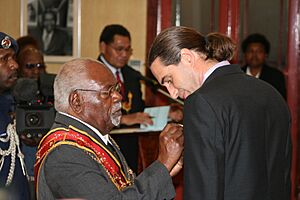
The monarch is seen as the source of all honours and awards. The King, as sovereign of Papua New Guinea, gives out awards in his name. These are often given based on the advice of Papua New Guinean ministers.
Papua New Guinea has its own national awards system called "The Orders of Papua New Guinea". This system was started in 2005 by Queen Elizabeth II. The King is the head of these Orders. The governor-general is the chancellor and a main leader of the Order of Logohu.
The Crown and the Defence Force
The Crown is at the top of the Papua New Guinea Defence Force. Papua New Guinea's navy ships use the prefix HMPNGS, which means His Majesty's Papua New Guinea Ship. The St Edward's Crown appears on the Defence Force's rank badges. This shows the King as the source of authority.
Members of the Defence Force have taken part in royal events. These include the Platinum Jubilee of Queen Elizabeth II and the coronation of King Charles III.
Members of the royal family also serve as colonels-in-chief of different regiments. This shows the Crown's connection with the Defence Force. Charles III is the Colonel-in-Chief of Papua New Guinea's Royal Pacific Islands Regiment. In 2012, King Charles, wearing the regiment's uniform, presented new flags to the troops.
The Crown and the Police
The national police force of Papua New Guinea is called the "Royal Papua New Guinea Constabulary". It was given the title "Royal" by King George VI in 1939. In 1953, 25 members of the Constabulary represented Papua New Guinea at the coronation of Queen Elizabeth II.
The Crown is also at the top of the Royal Papua New Guinea Constabulary. The governor-general is the Commandant of the Force. The St. Edward's Crown appears on the Constabulary's badges and rank insignia. This shows the King as the source of authority.
The Crown and Tok Pisin Language
In the creole language of Tok Pisin, Queen Elizabeth II was called Misis Kwin, Mama Kwin, Sina Bada, Big Mum, and Mama belong big family. Her husband, Prince Philip, Duke of Edinburgh, was called Oldfella Pili-Pili Him Bilong Misis Kwin. As the next in line to the throne, King Charles III was known as Nambawan pikinini bilong Misis Kwin ("The first child of Mrs Queen").
Members of the royal family have often spoken in Tok Pisin during their visits. In 1982, the Queen gave a famous speech in Tok Pisin, saying, “Mi hamamas tru long istap wantaim yupla nau, na mi ting bai mi kam bek long lukim yupla lo taim bihain.” (meaning, “I am delighted to be with you now and hope to return in the future”). Prince Charles also used the language in his speeches.
In 1984, Charles, Prince of Wales, visited Manus Island. In a special ceremony, he was crowned the Tenth Lapan of Manus. He accepted the title by saying, “Wuroh, wuroh, wuroh, all man meri bilong Manus. Mi hammamas tru.” (“Thank you all men and women of Manus. I am truly filled with happiness”).
In 2012, during a tour for the Diamond Jubilee of Elizabeth II, Charles, Prince of Wales, again introduced himself in Tok Pisin as “nambawan pikinini bilong Misis Kwin”. He shared greetings from the Queen of Papua New Guinea.
The Princess Royal, during her visit in 2022 for the Queen's Platinum Jubilee, mentioned that her family often talked about the Tok Pisin words they remembered.
Royal Symbols
Royal symbols are the visual signs of the monarchy in Papua New Guinea. The most important symbol is the King himself. His picture is used in public buildings and government offices to show Papua New Guinean sovereignty. Queen Elizabeth II's picture, for example, appears on medals and stamps. A statue of Queen Elizabeth II is also at Government House in Port Moresby. A St Edward's Crown is also shown on various medals and awards. This shows the monarch's role as the source of all honours.
The King's Official Birthday is a public holiday in Papua New Guinea, usually celebrated in June. There are celebrations at hotels, sports matches, and fireworks displays. Awards and medals are given to Papua New Guineans for public service on this day.
-
The flag of the governor-general of Papua New Guinea with St Edward's Crown.
-
St Edward's Crown on the insignia of the Grand Companion of the Order of Logohu.
- Artworks
Papua New Guinean artists have painted many unique pictures of the monarch. One famous painting is Missis Kwin by Mathias Kauage. It was given to the Queen in 1996. In the painting, the Queen wears a Gerua, a special ceremonial headdress. A Gerua is made of carved wood and painted to look like bird-of-paradise feathers. The artist said the painting shows the Queen as Head of the Commonwealth.
To celebrate Queen Elizabeth II's Golden Jubilee in 2002, an art show was held in Papua New Guinea. Artists were asked to paint a portrait of the Queen. The winning painting by Laben John was given to the Queen. Another painting, Her Majesty in the Land of the Unexpected by Jeffry Feeger, shows the Queen in traditional Papua New Guinean clothing. This painting is now displayed in London.
For Papua New Guinea's 50th anniversary of independence in 2025, an art competition was held for schools in Port Moresby. Students designed a mural of King Charles III. The winning artwork will be painted on a wall around the Sir Hubert Murray Stadium.
Royal Visits
Prince Philip, Duke of Edinburgh, visited Papua New Guinea from 1956 to 1957. Prince Edward and Katherine, the Duke and Duchess of Kent, visited in 1969 to open the 1969 South Pacific Games.
Queen Elizabeth II first visited Papua New Guinea in February 1974 with Prince Philip and other family members. They toured Rabaul, Goroka, and Lae. In Port Moresby, they received a 21-gun salute. The Post Courier newspaper said that the Queen had brought the monarchy closer to the people.
The Queen returned in 1977 for her Silver Jubilee tour. She visited Port Moresby, Popondetta, and Alotau. In a speech, she said she hoped the Crown would help keep the country united. The Queen and Duke visited again in 1982. They were greeted by over 100,000 people in traditional dress. The Queen congratulated the country on its progress.
Charles, Prince of Wales, visited in 1966 as a student. He represented the Queen at the independence celebrations in 1975. Charles visited again in 1984 to open the new parliament building. Prince Andrew, Duke of York visited in 1991 to open the 1991 South Pacific Games. Anne, Princess Royal visited in 2005 for the 30th anniversary of independence.
The Prince of Wales visited in 2012 for the Queen's Diamond Jubilee. He and the Duchess met many people in Port Moresby. Prince Andrew, Duke of York, visited in 2015 to open the 2015 Pacific Games.
The Princess Royal visited in April 2022 for the Queen's Platinum Jubilee. She and her husband, Vice Admiral Sir Timothy Laurence, visited schools, hospitals, and war cemeteries.
King Charles III is expected to visit Papua New Guinea in 2025 to celebrate the 50th anniversary of independence.
Views on the Monarchy
Many people in Papua New Guinea have admired the royal family for a long time. In 2022, Governor-General Sir Bob Dadae said that Papua New Guineans were "honoured and proud" to have the Queen as their head of state. During her 2022 visit, the Princess Royal thanked Papua New Guineans for their "loyalty and respect" for the Queen.
In 1983, a report suggested replacing the monarchy with a president from Papua New Guinea. Many politicians supported this idea. However, the government did not act on these recommendations.
Justin Tkatchenko, Minister for National Events, said in 2022 that Papua New Guinea would not become a republic. He said the country was embracing its monarchy. After the Queen's death in 2022, Prime Minister James Marape said that Papua New Guinea's relationship with the monarchy is "very important". He added that the country had "learnt to embrace royalty" because of Queen Elizabeth II.
A 2023 survey found that 45% of people supported becoming a republic, while 51% preferred to keep the monarchy. In May 2023, Prime Minister Marape said that Papua New Guineans are used to traditions and systems like the monarchy. He said it reminds them of their own traditional leadership systems that brought order and stability. He also linked their loyalty to the Crown to their shared history with Britain.
List of Papua New Guinean Monarchs
| Portrait | Regnal name (Birth–Death) |
Reign over Papua New Guinea | Full name | Consort | House | |
|---|---|---|---|---|---|---|
| Start | End | |||||
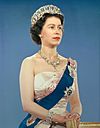 |
Elizabeth II (1926–2022) |
16 September 1975 | 8 September 2022 | Elizabeth Alexandra Mary | Philip Mountbatten | Windsor |
| Governors-general: Sir John Guise, Sir Tore Lokoloko, Sir Kingsford Dibela, Sir Ignatius Kilage, Sir Vincent Serei Eri, Sir Wiwa Korowi, Sir Silas Atopare, Sir Paulias Matane, Sir Michael Ogio, Sir Bob Dadae Prime ministers: Michael Somare, Julius Chan, Paias Wingti, Rabbie Namaliu, Bill Skate, Mekere Morauta, Peter O'Neill, James Marape |
||||||
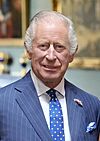 |
Charles III (b. 1948) |
8 September 2022 | present | Charles Philip Arthur George | Camilla Shand | Windsor |
| Governors-general: Sir Bob Dadae Prime ministers: James Marape |
||||||
More to Explore
- 50th Independence Anniversary King's Medal
- Lists of office-holders
- List of prime ministers of Elizabeth II
- List of prime ministers of Charles III
- List of Commonwealth visits made by Elizabeth II
- Monarchies in Oceania
- List of monarchies


